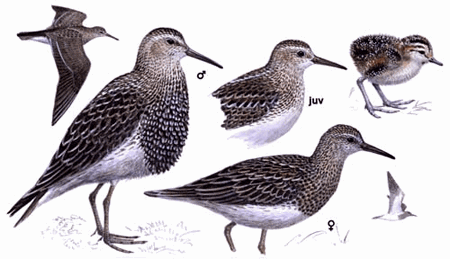
Pectoral Sandpiper
[order] CHARADRIIFORMES | [family] Scolopacidae | [latin] Calidris melanotos | [UK] Pectoral Sandpiper | [FR] Becasseau a poitrine cendree | [DE] Graubrust-Strandlaufer | [ES] Correlimos Pectoral | [NL] Gestreepte Strandloper
Subspecies
Monotypic species
Physical charateristics
Described as a larger version of a Least Sandpiper, the Pectoral Sandpiper is a medium-sized shorebird with a heavily streaked breast, sharply contrasting clear, white belly, and yellowish legs. The bill droops and is black at the tip, and lighter brown at the base. In flight, the tail shows a dark stripe down the middle, with white on either side. The upper wing has a very narrow stripe. Males are larger than females, and males have inflatable sacs in their breasts, used in courtship. Pectoral Sandpipers move along steadily with their heads down, picking up prey on the surface and probing lightly into the sand or mud. They usually forage in vegetation, and when they are disturbed, they stand upright with their necks extended, peering over the grass.
Listen to the sound of Pectoral Sandpiper
[audio:http://www.aviflevoland.nl/sounddb/P/Pectoral Sandpiper.mp3]
Copyright remark: Most sounds derived from xeno-canto
| wingspan min.: | 38 | cm | wingspan max.: | 45 | cm |
| size min.: | 19 | cm | size max.: | 23 | cm |
| incubation min.: | 21 | days | incubation max.: | 23 | days |
| fledging min.: | 18 | days | fledging max.: | 23 | days |
| broods: | 1 | eggs min.: | 3 | ||
| eggs max.: | 4 |
Range
North America, Eurasia : North
Habitat
Pectoral Sandpipers breed all across the North American Arctic and across northern Siberia at the dry edges of well-vegetated wetlands. During migration, they can be found in fresh- and saltwater marshes, on mudflats, or drying lakes and wet meadows. They winter in South American grasslands.
Reproduction
Pectoral Sandpipers are promiscuous: males mate with multiple females, and females mate with multiple males. Males arrive on the breeding grounds before females and establish territories. When females arrive, the males attract them with a flight display, rhythmically expanding and contracting the air sacs in their breasts. The female builds a nest in a grassy spot on the ground, often on a slightly elevated spot. The nest is usually a well-hidden scrape lined with grass and leaves, sometimes under low shrubs. She provides all the parental care. Incubation lasts for 21 to 23 days, and the four chicks leave the nest and feed themselves soon after hatching. The female stays with the young for about 10 to 20 days. The young start to fly at around 21 days, and are capable flyers by 30 days.
Feeding habits
During the breeding season, Pectoral Sandpipers eat flies and fly larvae, spiders, and seeds. During migration, they eat small crustaceans and other aquatic invertebrates, although insects may still be the major food.
Conservation
This species has an extremely large range, and hence does not approach the thresholds for Vulnerable under the range size criterion (Extent of Occurrence <20,000 km2 combined with a declining or fluctuating range size, habitat extent/quality, or population size and a small number of locations or severe fragmentation). The population trend appears to be stable, and hence the species does not approach the thresholds for Vulnerable under the population trend criterion (>30% decline over ten years or three generations). The population size may be moderately small to large, but it is not believed to approach the thresholds for Vulnerable under the population size criterion (<10,000 mature individuals with a continuing decline estimated to be >10% in ten years or three generations, or with a specified population structure). For these reasons the species is evaluated as Least Concern.

Migration
Migratory. Occasional in winter in southern USA, but otherwise a transequatorial migrant, wintering mainly in southern South America. Much the commonest Nearctic vagrant to Europe, and annual in autumn (late August to mid-October) in Britain and Ireland. Relatively high frequency of occurrence believed linked to strong south-east movement across Canada in autumn, leading to overshooting of Canadian coast. Though some vagrants may reach Europe westwards from Siberia, British and Irish autumn arrivals normally associated with Atlantic depressions. The few European spring records probably also transatlantic vagrants from previous autumns, as perhaps are some early autumn records from North Sea fringes.
Distribution map

